Get ready to embark on a sweet journey as we delve into the age-old debate of palm sugar vs cane sugar. Brace yourself for a sugar rush as we uncover the secrets behind these two sweet sensations. Whether you’re a health-conscious individual or a self-proclaimed sugar addict, this blog post will satisfy your cravings for knowledge and leave you with a sweet tooth that can’t be ignored. So, grab your favorite sugary treat and join us on this adventure through the sweetness spectrum.
Palm Sugar vs Cane Sugar: Unveiling the Sweetness Spectrum
In the realm of natural sweeteners, palm sugar and cane sugar stand out as two popular choices, each possessing unique characteristics and culinary applications. Derived from nature’s bounty, these sugars offer a delightful symphony of flavors and textures, while also presenting distinct nutritional profiles. Let’s embark on a journey to explore the captivating world of palm sugar and cane sugar, unraveling their differences and discovering their culinary versatility.
Origins and Production: A Tale of Two Sugars
Palm sugar, a gift from the tropics, is extracted from the sap of various palm tree species. This liquid gold, once collected, undergoes a gentle process of boiling and evaporation, coaxing it into a thick syrup that solidifies upon cooling, yielding palm sugar’s distinctive grainy texture.
In contrast, cane sugar originates from the sugarcane plant, a towering grass native to tropical and subtropical regions. Through a more intensive process, sugarcane stalks are crushed, releasing their sweet juices. These juices are then subjected to a series of purification and crystallization steps, resulting in the familiar white granulated sugar that graces our kitchen shelves.
Flavor Profiles: A Symphony of Sweetness
Palm sugar enchants the palate with its rich, caramel-like flavor, a symphony of earthy, smoky, and subtly sweet notes. Its moist texture imparts a unique depth of flavor, making it a culinary treasure in both sweet and savory dishes.
Cane sugar, on the other hand, exhibits a clean, straightforward sweetness, its flavor profile less pronounced than that of palm sugar. This neutral taste makes it a versatile ingredient, seamlessly blending into a wide array of culinary creations.
Nutritional Nuances: Unveiling the Health Spectrum
Palm sugar emerges as the healthier choice, boasting a lower glycemic index (GI) than cane sugar. This means that it causes a slower and steadier rise in blood sugar levels, making it a more suitable sweetener for individuals with diabetes or those seeking to manage their blood sugar.
Additionally, palm sugar retains a treasure trove of essential minerals, including potassium, magnesium, zinc, iron, and B vitamins. These nutrients contribute to overall health and well-being, elevating palm sugar beyond a mere sweetener to a source of vital nourishment.
Culinary Delights: A Sweet Journey Across Cuisines
Palm sugar’s distinctive flavor profile shines in savory dishes, lending its smoky sweetness to curries, marinades, sauces, and dressings. Its grainy texture adds a delightful textural element, elevating these culinary creations to new heights.
Cane sugar, with its versatile sweetness, excels in bakery items, imbuing cakes, cookies, and bread with a tantalizing sweetness. Its neutral flavor allows other ingredients to shine, making it a harmonious addition to a myriad of sweet treats.
Sustainability: Sweetness with a Conscience
Palm sugar production often employs sustainable practices, contributing to a greener planet. Palm trees require less water and land resources compared to sugarcane, and their cultivation can help maintain soil fertility. Moreover, palm sugar production often supports small-scale farmers, fostering economic empowerment in rural communities.
Cane sugar production, while more resource-intensive, can also be conducted sustainably through the use of renewable energy sources and crop rotation practices. Choosing sustainably produced cane sugar helps minimize environmental impact and supports responsible farming practices.
Conclusion: A Sweet Symphony of Choice
Palm sugar and cane sugar, each with its unique flavor profile, nutritional composition, and culinary applications, offer a world of sweetness to explore. Whether you seek the rich depths of palm sugar or the understated sweetness of cane sugar, the choice is yours to make. Indulge in these natural sweeteners with moderation, savoring their culinary delights while maintaining a balanced and healthy lifestyle.
FAQ about Palm Sugar vs Cane Sugar
Q: What is palm sugar?
A: Palm sugar is a natural sweetener extracted from the sap of various palm tree species.
Q: How is palm sugar produced?
A: Palm sugar is produced by boiling and evaporating the collected sap, resulting in a thick syrup that solidifies into palm sugar’s grainy texture.
Q: Where does cane sugar come from?
A: Cane sugar comes from the sugarcane plant, a tall grass native to tropical and subtropical regions.
Q: How does palm sugar differ from cane sugar?
A: Palm sugar and cane sugar differ in their sources, with palm sugar coming from palm trees and cane sugar coming from sugarcane plants.
Q: What are the culinary applications of palm sugar?
A: Palm sugar is commonly used in Southeast Asian cuisine, adding a unique flavor to dishes such as curries, desserts, and sauces.
Q: Is there a difference in nutritional profiles between palm sugar and cane sugar?
A: Yes, there is a difference. Palm sugar contains trace amounts of vitamins and minerals, while cane sugar is primarily composed of sucrose and provides empty calories.


